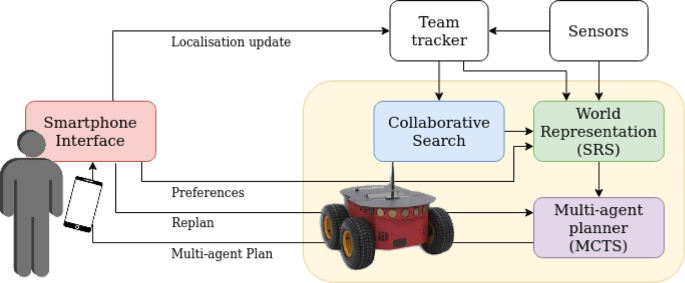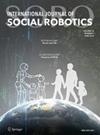人机协同导航的共享任务表示:协同搜索案例
IF 3.8
2区 计算机科学
Q2 ROBOTICS
引用次数: 0
摘要
摘要近年来,人机协作(HRC)的研究已经扩展到许多分支领域。许多都显示出相当大的进步,但人机协作导航(HRCN)领域似乎停留在隐式协作设置、假设或模拟任务分配问题、共享自主权或让人类作为管理者上。这项工作向前迈进了一步,提出了一个能够处理现实世界人机协作导航任务的端到端系统。该系统利用社会奖励源模型(Social Reward Sources model, SRS)这一知识表示来同时处理任务分配和路径规划,提出了一种人机团队的多智能体蒙特卡罗树搜索(MCTS)规划器,将协作搜索作为HRCN的测试平台,并研究了智能手机在此环境下的通信使用情况。详细的实验证明了该方法的可行性,探索了人机团队采用的协作角色,并测试了不同通信接口设计的可接受性和实用性。本文章由计算机程序翻译,如有差异,请以英文原文为准。

Shared Task Representation for Human–Robot Collaborative Navigation: The Collaborative Search Case
Abstract Recent research in Human Robot Collaboration (HRC) has spread and specialised in many sub-fields. Many show considerable advances, but the human–robot collaborative navigation (HRCN) field seems to be stuck focusing on implicit collaboration settings, on hypothetical or simulated task allocation problems, on shared autonomy or on having the human as a manager. This work takes a step forward by presenting an end-to-end system capable of handling real-world human–robot collaborative navigation tasks. This system makes use of the Social Reward Sources model (SRS), a knowledge representation to simultaneously tackle task allocation and path planning, proposes a multi-agent Monte Carlo Tree Search (MCTS) planner for human–robot teams, presents the collaborative search as a testbed for HRCN and studies the usage of smartphones for communication in this setting. The detailed experiments prove the viability of the approach, explore collaboration roles adopted by the human–robot team and test the acceptability and utility of different communication interface designs.
求助全文
通过发布文献求助,成功后即可免费获取论文全文。
去求助
来源期刊

International Journal of Social Robotics
ROBOTICS-
CiteScore
9.80
自引率
8.50%
发文量
95
期刊介绍:
Social Robotics is the study of robots that are able to interact and communicate among themselves, with humans, and with the environment, within the social and cultural structure attached to its role. The journal covers a broad spectrum of topics related to the latest technologies, new research results and developments in the area of social robotics on all levels, from developments in core enabling technologies to system integration, aesthetic design, applications and social implications. It provides a platform for like-minded researchers to present their findings and latest developments in social robotics, covering relevant advances in engineering, computing, arts and social sciences.
The journal publishes original, peer reviewed articles and contributions on innovative ideas and concepts, new discoveries and improvements, as well as novel applications, by leading researchers and developers regarding the latest fundamental advances in the core technologies that form the backbone of social robotics, distinguished developmental projects in the area, as well as seminal works in aesthetic design, ethics and philosophy, studies on social impact and influence, pertaining to social robotics.
 求助内容:
求助内容: 应助结果提醒方式:
应助结果提醒方式:


